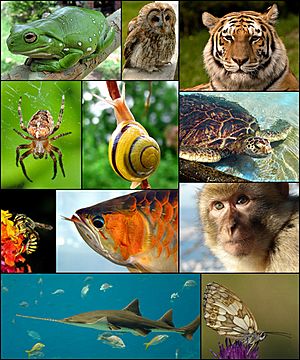Nephrozoa facts for kids
The Nephrozoa (also called Eubilateria) are a huge group of animals that includes most animals you know! This group contains animals like humans, insects, worms, and snails. They are called "bilaterian" animals because their bodies have a special kind of symmetry: if you draw a line down the middle, both sides are almost mirror images of each other. Think of a human, a dog, or a butterfly – they all have this kind of symmetry.
Nephrozoa are divided into two main supergroups: the Deuterostomia and the Protostomia. These groups are different based on how their bodies develop when they are just tiny embryos.
Quick facts for kids Nephrozoa |
|
|---|---|
 |
|
| Diversity of nephrozoans | |
| Scientific classification |
|
| (unranked): | Holozoa |
| (unranked): | Filozoa |
| Kingdom: | Animalia |
| Subkingdom: | Eumetazoa |
| Clade: | ParaHoxozoa |
| Clade: | Bilateria |
| Clade: | Nephrozoa Jondelius et al. , 2002 |
| Phyla | |
|
|
| Synonyms | |
|
Eubilateria Peter Ax, 1987 |
|
Contents
Two Main Groups of Nephrozoa
The Nephrozoa are divided into two major branches based on how their first body opening forms during development. This opening is called the "blastopore."
Deuterostomes: Our Animal Relatives
The word "Deuterostome" means "second mouth." In these animals, the first opening that forms in the embryo becomes the anus. The mouth develops later, as a second opening.
- Chordates: This group includes all animals with a notochord (a flexible rod that supports the body), like fish, amphibians, reptiles, birds, and mammals (including humans!).
- Echinoderms: These are sea animals like starfish, sea urchins, and sea cucumbers. They often have spiny skin.
- Hemichordates: These are marine worms, like acorn worms, that share some features with chordates.
Protostomes: Diverse Invertebrate Animals
The word "Protostome" means "first mouth." In these animals, the first opening that forms in the embryo becomes the mouth. The anus develops later. This group is incredibly diverse and includes most of the invertebrate animals on Earth.
Ecdysozoa: Animals That Shed Their Skin
This large group of protostomes is special because they grow by shedding their outer layer, or exoskeleton. This process is called molting (or ecdysis).
- Arthropods: This is the largest group of animals on Earth! It includes insects, spiders, crabs, and centipedes. They all have jointed legs and a hard outer shell.
- Nematodes: Also known as roundworms, these are very common worms found in soil, water, and even inside other animals.
- Onychophorans: These are unique, caterpillar-like creatures that live in humid places.
- Tardigrades: Often called "water bears," these tiny animals are famous for being able to survive extreme conditions.
Spiralia: Animals with Spiral Development
This group of protostomes is named for a special way their cells divide in the early embryo, often in a spiral pattern. They include many types of worms and shelled animals.
- Molluscs: This group includes snails, slugs, clams, oysters, octopuses, and squids. Many have soft bodies and a shell.
- Annelids: These are segmented worms, like earthworms and leeches. Their bodies are made of many similar rings.
- Platyhelminthes: These are flatworms, like planarians and tapeworms. They have very simple bodies.
- Rotifers: These are tiny, microscopic animals often found in fresh water. They have a "wheel-like" structure near their mouth.
- Bryozoans: Also known as "moss animals," these are tiny aquatic animals that live in colonies.
When Did Nephrozoa Appear?
Scientists believe that Nephrozoa first appeared a very long time ago, around 558 million years ago, during a period called the Ediacaran period. This makes them one of the oldest groups of complex animals on our planet. They have continued to evolve and diversify ever since, leading to the incredible variety of animals we see today.
See also
 In Spanish: Nephrozoa para niños
In Spanish: Nephrozoa para niños

